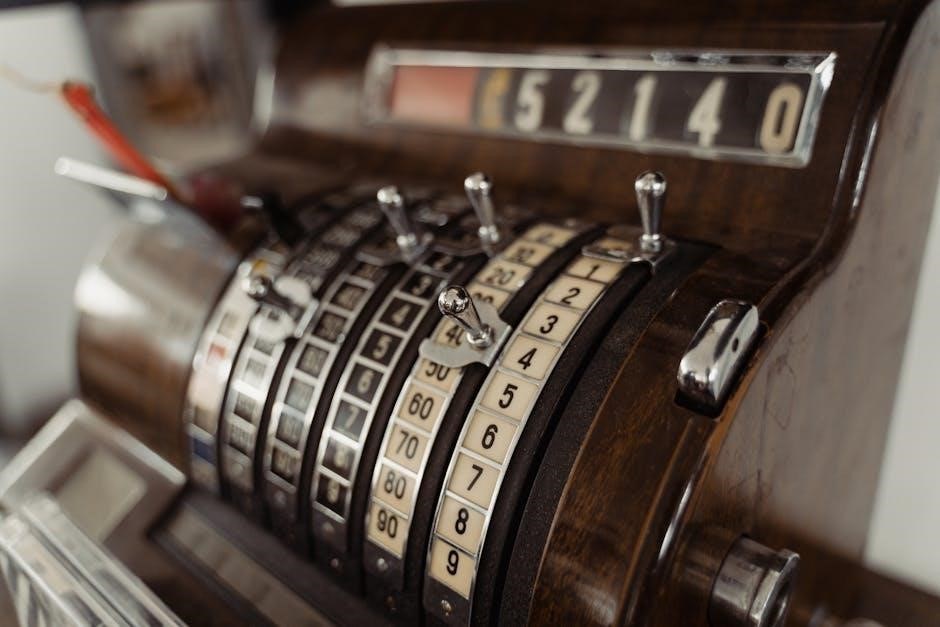A Place Value Decimal Chart is a visual tool that helps students understand the positional value of digits in whole numbers and decimals. It organizes numbers into columns, such as ones, tenths, hundredths, and thousandths, making it easier to identify and compare values. This chart is essential for teaching mathematical concepts like decimal representation, fraction conversion, and numerical operations. By breaking down numbers into their place values, it simplifies complex math problems and enhances learning outcomes for students of all ages.
1.1 Definition and Purpose
A Place Value Decimal Chart is a visual tool designed to illustrate the positional value of digits in whole numbers and decimals. It organizes numbers into columns, such as ones, tenths, hundredths, and thousandths, helping users understand their relative values. The chart’s primary purpose is to simplify the teaching and learning of place value concepts, enabling students to identify and compare numerical values effectively. It serves as a foundational resource for mastering math operations and real-life applications involving decimals and whole numbers.
1.2 Importance of Understanding Place Value in Decimals
Understanding place value in decimals is crucial for grasping numerical relationships and performing precise calculations. It helps students recognize the significance of each digit, enabling them to compare, order, and operate with decimals confidently. This knowledge is foundational for real-world applications, such as financial transactions and scientific measurements, where accuracy is vital. By mastering place value, learners can avoid common errors and develop a stronger mathematical foundation, making it easier to understand fractions, ratios, and more complex concepts in the future.

Structure of the Place Value Decimal Chart
The chart is divided into two main sections: whole number places (ones, tens, hundreds, thousands) and decimal places (tenths, hundredths, thousandths, ten-thousandths). Each column represents a specific place value, helping users visualize numerical relationships clearly and systematically.
2.1 Whole Number Places (Ones, Tens, Hundreds, Thousands)
The whole number section of the chart displays place values to the left of the decimal point, starting with ones, then tens, hundreds, and thousands; Each column represents a tenfold increase in value, helping students understand the progression of numbers. For example, 1 in the tens place equals 10 ones, while 1 in the hundreds place equals 100 ones. This hierarchical structure simplifies the breakdown of complex numbers into manageable parts, enhancing comprehension and arithmetic skills.
2.2 Decimal Places (Tenths, Hundredths, Thousandths, Ten-Thousandths)
The decimal places section of the chart, located to the right of the decimal point, includes tenths, hundredths, thousandths, and ten-thousandths. Each position represents a fraction of a whole, with values decreasing by powers of ten. Tenths are the first decimal place, equal to 1/10, followed by hundredths (1/100), thousandths (1/1000), and ten-thousandths (1/10,000). This structure helps students visualize and understand the relationships between decimal fractions and their place values, making it easier to work with decimal numbers in various mathematical operations.
2.3 Visual Representation of the Chart
The Place Value Decimal Chart is typically structured with columns representing each place value, from whole numbers (ones, tens, hundreds) to decimals (tenths, hundredths, thousandths). Each column is labeled with its place value, and numbers are aligned beneath their respective headings. This clear, organized layout allows students to visually track how digits change value based on their position. The chart often includes placeholders for each digit, making it easier to identify and compare values at a glance. This visual structure simplifies understanding of both whole numbers and decimals.

How to Read the Place Value Decimal Chart
The chart breaks down numbers into place values, aligning digits under their respective headings. This helps identify whole numbers and decimals, making conversions and operations straightforward.
3.1 Identifying Place Values to the Left of the Decimal Point
To the left of the decimal point, numbers are organized into place values such as ones, tens, hundreds, and thousands. Each position represents a power of ten, with the ones place being the smallest unit. For example, in the number 642, the digit 6 is in the hundreds place, 4 is in the tens place, and 2 is in the ones place. Understanding these positions is crucial for accurately reading and interpreting whole numbers. This foundational skill is essential for building proficiency in mathematics.
3.2 Identifying Place Values to the Right of the Decimal Point
To the right of the decimal point, numbers are divided into tenths, hundredths, thousandths, and ten-thousandths. Each position represents a fraction of a whole, with values decreasing as you move right. For example, in 0.4321, 4 is in the tenths place (0.4), 3 in the hundredths (0.03), 2 in the thousandths (0.002), and 1 in the ten-thousandths (0.0001). Understanding these place values is essential for accurately interpreting and working with decimals in real-life applications like money, measurements, and science. This skill builds a strong foundation for advanced mathematical operations.
3;3 Understanding the Relationship Between Digits and Their Positions
Each digit’s position in a number determines its value, whether to the left or right of the decimal point. To the left, digits represent whole number values like ones, tens, and hundreds. To the right, they represent fractions such as tenths, hundredths, and thousandths. For example, in 3.45, the digit 3 is in the ones place, 4 is in the tenths place (0.4), and 5 is in the hundredths place (0.05). This positional understanding is crucial for accurate calculations and real-world applications like money management and scientific measurements.

Educational Uses of the Place Value Decimal Chart
The Place Value Decimal Chart is a versatile educational tool that simplifies teaching and learning of decimal concepts. It helps students recognize decimal places, compare and order decimals, convert decimals to fractions, and perform operations like addition and subtraction. This chart enhances understanding and retention of complex mathematical concepts, making it an invaluable resource for classrooms and independent study.
4.1 Teaching Students to Recognize Decimal Places
The Place Value Decimal Chart is an excellent tool for teaching students to recognize decimal places. It visually breaks down numbers into tenths, hundredths, thousandths, and ten-thousandths, helping students understand the positional value of each digit. By aligning digits under their respective place values, the chart makes it easier for students to identify and name each decimal place accurately. This clarity aids in building a strong foundation for more complex decimal operations and real-world applications.
4.2 Helping Students Compare and Order Decimals
The Place Value Decimal Chart is a valuable resource for teaching students to compare and order decimals. By visually aligning digits according to their place values, the chart simplifies the process of identifying greater or lesser values. Students can easily see how tenths, hundredths, and thousandths relate, enabling them to determine which number is larger or smaller. This tool also supports practical exercises, such as placing decimals on a number line or in ordered lists, fostering a deeper understanding of numerical relationships and preparation for advanced math concepts.
4.3 Assisting in the Conversion of Decimals to Fractions
The Place Value Decimal Chart is instrumental in helping students convert decimals to fractions. By aligning each decimal place (tenths, hundredths, thousandths) with its corresponding fractional form, the chart provides a clear visual connection. For instance, tenths correspond to 1/10, hundredths to 1/100, and thousandths to 1/1000. This direct correlation enables students to easily identify and write equivalent fractions, reinforcing their understanding of decimal-fraction relationships and enhancing their ability to perform conversions accurately.
4.4 Supporting the Understanding of Decimal Operations (Addition, Subtraction)
The Place Value Decimal Chart is an excellent tool for teaching decimal addition and subtraction. It helps students align digits correctly, ensuring proper place value alignment. By visually organizing numbers into tenths, hundredths, and thousandths, the chart minimizes errors during operations. Students can easily carry over or borrow values, just like with whole numbers, reinforcing their understanding of decimal arithmetic. This structured approach builds confidence and proficiency in performing decimal calculations accurately and efficiently.

Real-Life Applications of Decimal Place Value
Decimal place value is crucial in money management, scientific measurements, cooking, and engineering. It aids in precise calculations, ensuring accuracy in financial transactions, experiments, recipes, and technical designs.
5.1 Money Management and Financial Literacy
The Place Value Decimal Chart is invaluable in money management, helping individuals understand cents, taxes, and budgets. It clarifies how tenths represent dimes and hundredths represent pennies, essential for accurate financial calculations. By aligning decimal points, the chart aids in comparing prices and managing expenses. This tool is particularly useful for teaching students to handle monetary values, ensuring they grasp the relationship between dollars and cents. It fosters financial literacy, enabling precise budgeting and informed spending decisions.
5.2 Measurement in Science and Engineering
The Place Value Decimal Chart is instrumental in scientific and engineering measurements, where precision is critical. It helps interpret decimal values in metrics like millimeters, grams, and liters, ensuring accuracy. For instance, understanding tenths, hundredths, and thousandths is vital for reading measurements accurately. This tool aids in converting units, such as millimeters to meters, by aligning decimal points. It supports complex calculations in fields like physics and chemistry, ensuring error-free results. By clarifying decimal positions, it enhances the reliability of scientific data and engineering designs.
5.3 Everyday Uses in Cooking and Recipes
The Place Value Decimal Chart is a practical tool in cooking, where precise measurements are essential. It helps in understanding decimal values for ingredients, such as 0.5 cups of flour or 0.25 teaspoons of spice. By breaking down decimals into tenths, hundredths, and thousandths, the chart simplifies recipe scaling and unit conversions. This makes it easier to adjust ingredient quantities or follow intricate baking measurements. It also aids in teaching children about measurements while cooking, making math relevant and fun in daily life.

History and Evolution of Place Value Systems
The place value system originated in ancient Babylon and Egypt, evolving through Indian and Mayan innovations, with the zero concept revolutionizing decimal mathematics globally.
6.1 Ancient Civilizations and Their Number Systems
Ancient civilizations like Babylon, Egypt, and India laid the groundwork for place value systems. The Babylonians used a base-60 system, while Egyptians employed hieroglyphics with decimal-like structures. India introduced the concept of zero, revolutionizing decimal mathematics. These early systems emphasized positional notation, where digits’ values depended on their placement. The Mayans also developed a sophisticated positional system, including a zero concept. These innovations collectively influenced the evolution of modern place value charts, shaping how we understand and teach numerical systems today.
6.2 The Development of Decimal Systems
The decimal system evolved from ancient roots, with significant advancements in India during the Gupta period. Scholars like Aryabhata and Brahmagupta refined the concept of zero and positional notation. This system spread globally through trade and cultural exchange. The decimal system’s simplicity and efficiency made it a cornerstone of mathematics. By the Renaissance, it was widely adopted in Europe, leading to standardized place value charts. Its development revolutionized mathematics, commerce, and science, forming the basis of modern numerical systems used worldwide today.
6.3 Modern Tools for Teaching Place Value
Modern tools like interactive whiteboards, educational apps, and online platforms have transformed place value instruction. Resources such as Khan Academy and GeoGebra offer interactive place value charts, allowing students to visualize and manipulate digits. Printable PDF charts are widely available, providing a tactile learning experience. These tools cater to diverse learning styles, making place value concepts more accessible and engaging. They help students grasp decimal systems, fractions, and operations with ease, fostering a deeper understanding of numerical relationships and real-world applications.

Comparing Place Value Charts with Other Teaching Tools
Place value charts excel in breaking down numbers, while number lines and fraction bars offer unique benefits for operations and fraction-decimal connections. Digital tools enhance engagement and accessibility.
7.1 Number Lines for Decimal Representation
Number lines are effective tools for visualizing decimal representation, allowing students to see the progression of values from left to right. Unlike place value charts, number lines emphasize the continuous nature of numbers, making it easier to understand transitions between whole numbers and decimals. They are particularly useful for operations like addition and subtraction, as students can “jump” along the line to compute results. Number lines also help students recognize intervals and sequences, making them a versatile complement to place value charts for teaching decimal concepts.
7.2 Fraction Bars and Their Role in Decimal Understanding
Fraction bars are visual tools that represent parts of a whole, helping students connect decimals to their fractional equivalents. They complement place value charts by providing a concrete representation of abstract decimal concepts. For example, a fraction bar divided into ten parts can illustrate tenths, while smaller divisions represent hundredths or thousandths. This visual connection enhances students’ ability to convert decimals to fractions and understand their proportional relationships. Fraction bars are particularly effective for teaching how decimals relate to whole numbers and fractions, fostering a deeper mathematical understanding. They are often used alongside place value charts to reinforce these connections.
7.3 Interactive Digital Tools for Place Value Learning
Interactive digital tools, such as Khan Academy’s decimal place value resources, offer engaging ways to explore place value concepts. These tools often feature virtual manipulatives, like draggable coins or blocks, to represent whole numbers and decimals. Students can visually break down numbers into their place values, enhancing their understanding of tenths, hundredths, and thousandths. Digital charts and games provide real-time feedback, allowing learners to experiment and correct mistakes. These tools are particularly effective for visual and kinesthetic learners, making place value lessons more dynamic and accessible.

Teaching Strategies for Effective Use of the Chart
Effective teaching strategies involve using the chart as a visual aid, incorporating manipulatives, and providing step-by-step instruction. Guided practice and interactive activities enhance student engagement and understanding of decimal place values.
8.1 Step-by-Step Instruction for Beginners
Begin with whole numbers, introducing the concept of ones, tens, and hundreds. Gradually transition to decimals, explaining tenths, hundredths, and thousandths. Use the chart to visualize each digit’s position and value. Provide hands-on activities with manipulatives, such as coins or fraction bars, to reinforce learning. Offer clear examples, like aligning tenths and hundredths for addition. Encourage students to apply the chart to real-world problems, such as money management, to deepen their understanding and confidence in working with decimals.
8.2 Incorporating Manipulatives for Hands-On Learning
Using manipulatives, such as coins, place value blocks, or fraction bars, enhances understanding of decimal place values. These tools allow students to physically explore and visualize digits in whole numbers and decimals. For example, coins can represent tenths and hundredths, while blocks can demonstrate the relationship between units and decimals. Hands-on activities make learning engaging and interactive, helping students grasp abstract concepts like tenths, hundredths, and thousandths through tangible experiences.
8.3 Encouraging Independent Practice with Worksheets
Worksheets are an effective way to reinforce understanding of decimal place values. They provide structured exercises, such as matching games, fill-in-the-blank activities, and decimal-to-fraction conversions, allowing students to practice independently. Printable PDF templates, like those found online, offer a variety of tasks tailored to different skill levels. Worksheets help students build confidence and fluency in identifying tenths, hundredths, and thousandths, making them a valuable tool for independent learning and mastery of decimal place value concepts.

Common Mistakes Students Make with Decimal Place Value
Students often misalign decimals during operations and confuse tenths with hundredths. Forgetting the relationship between decimals and fractions is another common error, hindering their understanding of place value concepts.
9.1 Misaligning Decimals During Operations
Misaligning decimals during operations is a common mistake, leading to incorrect results. Students often fail to properly line up the decimal points when adding or subtracting, mixing whole numbers and decimals. This error stems from a lack of understanding of place value. Using a Place Value Decimal Chart can help prevent this by visually organizing digits into correct columns, ensuring tenths align with tenths and hundredths with hundredths. This tool guides students to recognize and correct misalignments, fostering accuracy in mathematical operations and strengthening their grasp of decimal place value concepts.
9.2 Confusing Tenths with Hundredths
Confusing tenths and hundredths is a frequent error among students. Tenths represent the first place after the decimal point, while hundredths are the second. Misidentifying these can lead to incorrect calculations. A Place Value Decimal Chart helps clarify this by visually separating each decimal place. It highlights tenths as the first column to the right of the decimal and hundredths as the second, making it easier for students to distinguish between them and understand their respective values in a number.
9.3 Forgetting the Relationship Between Decimals and Fractions
Many students overlook the connection between decimals and their fractional equivalents, leading to confusion in conversions. For example, tenths (0.1) correspond to 1/10, while hundredths (0.01) equal 1/100. A Place Value Decimal Chart visually bridges this gap, aligning decimal places with their fraction forms. This oversight can hinder operations like addition and subtraction, as well as real-world applications like cooking or financial calculations. Using the chart helps students recognize these relationships, enhancing their ability to convert and compare decimals and fractions accurately.

Resources for Downloading or Creating a Place Value Decimal Chart
Find printable PDF templates online or create custom charts using digital tools. DIY guides and interactive templates are available, supporting educators and learners in understanding decimal place values effectively.
10.1 Printable PDF Templates Available Online
Printable PDF templates for place value decimal charts are widely available online, offering a convenient way to teach and learn decimal concepts. Websites like Twinkl and Khan Academy provide customizable charts that cater to various grade levels. These templates often include columns for ones, tenths, hundredths, and thousandths, making it easy for students to visualize and understand decimal placements. Educators can download and print these charts for classroom use or assign them as homework to reinforce learning. Many templates are free, while others may require a subscription or purchase. They are ideal for creating interactive lessons or independent practice worksheets, ensuring students grasp decimal place value effectively. Visit educational resource websites to explore and download these versatile tools today.
10.2 Digital Versions for Interactive Learning
Digital versions of place value decimal charts offer engaging and interactive ways to teach and learn decimal concepts. Platforms like Khan Academy and educational apps provide interactive charts with movable digits, drag-and-drop features, and real-time feedback. These tools allow students to explore decimal placements dynamically, enhancing their understanding of place value. Digital charts can also include animations, quizzes, and games, making learning more immersive and fun. They are accessible on tablets, smartphones, or computers, providing flexibility for both classroom and remote learning environments. These interactive tools are particularly effective for visual and kinesthetic learners, helping them grasp complex decimal relationships more effectively. By leveraging technology, digital charts make place value education more accessible and enjoyable for students of all ages.
10.3 DIY Tips for Making Your Own Chart
Creating a DIY place value decimal chart is a cost-effective and customizable way to teach or learn decimal concepts. Start by drawing a large chart on poster paper or a whiteboard, labeling columns for ones, tenths, hundredths, and thousandths. Use colored markers to differentiate each place value. Add movable tokens, stickers, or digits for hands-on practice. For durability, laminate the chart or use digital tools to design and print it. This method allows educators to tailor the chart to specific learning needs, making it adaptable for various age groups and skill levels. Homemade charts also encourage creativity and active participation in the learning process, helping students visualize and internalize decimal place values more effectively. Teachers can further enhance the chart by incorporating real-life examples, such as money or measurements, to illustrate practical applications of decimals. This personalized approach ensures that the chart is both functional and engaging for students, fostering a deeper understanding of place value systems.
11.1 Summary of Key Points
The Place Value Decimal Chart is an essential educational resource that helps students grasp the positional values of digits in whole numbers and decimals. It visually organizes numbers into columns such as ones, tenths, and hundredths, making it easier to understand and compare values. This chart is particularly useful for teaching decimal representation, fraction conversion, and numerical operations. By breaking down numbers into their place values, it simplifies complex math problems and enhances learning outcomes for students of all ages.
11.2 Final Thoughts on the Importance of Place Value Charts
The Place Value Decimal Chart is an indispensable tool for mastering foundational math skills, particularly in understanding decimals and their operations. It provides clarity and structure, making abstract concepts tangible for learners. By visually breaking down numbers, it aids in operations like addition and subtraction, while its real-world applications in finance and science highlight its practical relevance. Ultimately, this chart is a cornerstone for building strong numerical literacy and problem-solving abilities in students of all ages.

Leave a Reply
You must be logged in to post a comment.